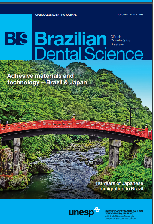Lingual mandibular bone defect: imaging features in panoramic radiograph, multislice computed tomography and magnetic resonance imaging
DOI:
https://doi.org/10.14295/bds.2018.v21i2.1557Abstract
Stafne bone defect or mandibular bone depression is defined as a bone developmental defect usually filled with soft or salivary gland tissue. Lingual posterior variant incidence is less than 0.5%. We reported a case of an 80 years old Asian female asymptomatic patient who underwent routine panoramic radiographic examination and a radiolucent area in mandible was noticed as an incidental finding, with an initial provisional diagnosis of traumatic bone cyst, aneurysmal bone cyst and lingual mandibular bone defect. The patient was then referred to multislice computed tomography and magnetic resonance imaging. Computed tomography showed a hypodense area with discontinuity in mandible base. Magnetic resonance imaging demonstrated a hyperintense image eroding mandibular body in contact with submandibular gland, which corresponded to fatty tissue and due to these imaging findings, the final diagnosis was lingual mandibular bone defect. Although the defect is a benign lesion and interventional treatment is not necessary, radiolucencies in mandible should be detailed investigated, due to their radiographic features that can resemble to other intrabony lesions. Imaging examinations can provide great defect details, especially magnetic resonance imaging, which can allow the identification of glandular tissue continuity to the mandibular defect.
Keywords
Bone cysts; Salivary glands; Magnetic resonance imaging; Computed tomography; Panoramic radiography.
Downloads
Downloads
Additional Files
Published
How to Cite
Issue
Section
License
Brazilian Dental Science uses the Creative Commons (CC-BY 4.0) license, thus preserving the integrity of articles in an open access environment. The journal allows the author to retain publishing rights without restrictions.
=================




























